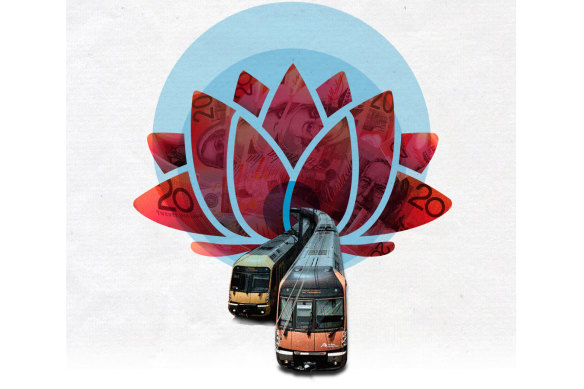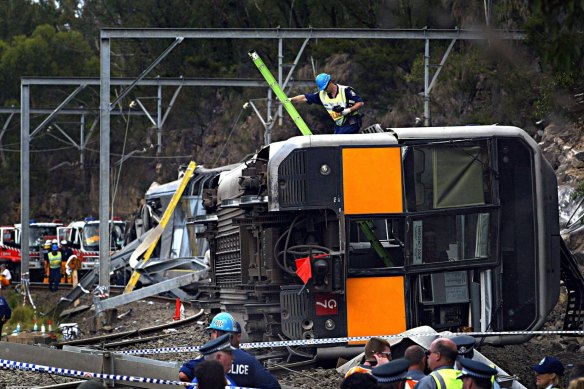This was published 4 years ago
The cover-up of a ‘financial mirage’ that has inflated the NSW budget and may put rail safety at risk
By Adele Ferguson and Matt O'Sullivan

Credit:
The NSW government has attempted to cover up how it artificially inflated the state’s budgets by tens of billions of dollars after it shifted the rail network’s costs onto a corporation that still hasn’t been able to properly operate six years after it was launched.
A trove of highly confidential documents and testimony of whistleblowers reveals NSW Treasury pressured accounting giant KPMG to delete or amend aspects of a report commissioned by Transport for NSW that found the plan could end up costing the state’s coffers more than it saved.
Whistleblowers fear the new structure will fragment accountability and could eventually lead to train disasters on the scale of the Waterfall or Glenbrook tragedies, which claimed the lives of 14 passengers.
The corporation, known as the Transport Asset Holding Entity (TAHE), was part of a plan hatched in 2014 to set up a shell corporation to shift billions of dollars of expenses off the state budget and into a new rail body.

Seven people were killed and dozens injured when a Tangara train derailed near Waterfall station, south of Sydney, in January 2003.Credit: Andrew Meares
NSW Treasury was able to use the corporation, with the approval of the Australian Bureau of Statistics, to inflate the budget to help mask the government slipping into deficit in 2018.
The KPMG report last year caused a deep rift between Treasury and Transport for NSW. On November 17, Transport for NSW secretary Rodd Staples was sacked “for no cause” after 15 years in the department.
Former NSW auditor-general Tony Harris estimates the entity’s reclassification from a government body to a commercial entity meant the government’s operating result has been bolstered by more than $30 billion over the last six years.
“It’s a financial mirage because you are seeing something that isn’t there,” Mr Harris said. “It was designed to avert the prospect of the state losing its AAA credit rating by creating an apparent surplus through an accounting gimmick.”
The ABS, which sets the rules on classifying government entities, agreed to allow the government to gain the benefits upfront on the proviso the new entity would meet key milestones in the “transition” to a commercial government-owned corporation by July 2018, according to a document marked “Cabinet in confidence” in 2016.
Until that happened it would be classified as a commercial entity in name only as it didn’t have a board or CEO and was not booking any revenue. That revenue would eventually come from requiring Sydney Trains and NSW Trains to pay access fees for the use of tracks and other assets it owned, which would be charged to the state budget.
The highly confidential analysis by KPMG for Transport last November found once TAHE started earning revenue by charging the government-owned Sydney Trains and NSW Trains access fees, the costs to the budget would far outweigh the benefits.
The Herald can reveal the Auditor-General had been denied access to the controversial KPMG report in helping it audit the state’s finances.
Despite multiple warnings about the long-term safety and financial implications, including in cabinet papers dating back to 2016, Treasury pushed ahead to preserve what has been described by a whistleblower as a “public sector Enron”.
“Enron was all about using accounting profits to mask cash losses and TAHE is the same, the only difference is it is owned by taxpayers who will pick up the costs when it’s wound up,” said another whistleblower who had expertise in finance and who sought anonymity due to the sensitivity of the matter.
Former counsel assisting the Independent Commission Against Corruption Geoffrey Watson, SC, who is a director of the Centre for Public Integrity, said the watchdog needed to investigate the attempted cover-up and dismissal of Mr Staples as Transport secretary.
“This is disturbing on so many levels. This is a crude accounting technique to pretend that billions of dollars don’t get reported into the budget,” he said. “This needs to go to ICAC. It is a bad practice to obtain an opinion from an external consultancy then try to get them to alter it.”
Labor MP and leadership contender Michael Daley, who has been raising concerns about TAHE in Parliament for years, said he didn’t realise how fraudulent it was until he received the KPMG report from whistleblowers.
“The Auditor-General must examine this rort. TAHE is the most dishonest budgetary fraud ever concocted by a NSW state government and it goes all the way to the top ... [Dominic] Perrottet and [Andrew] Constance are all in the gun here,” he said.
Mr Daley said the budget that would be handed down later this month would be based on lies.
The Herald can also reveal senior transport officials feared the new structure could repeat the 1990s carve-up of NSW railways and the resulting gaps in safety and investment accountabilities; key factors in the 1999 Glenbrook and 2003 Waterfall rail disasters.
“It creates an environment of competing priorities and a lack of clarity of who is truly accountable, and in doing so it seeds the possibility of poor decisions that will lead to safety incidents unnecessarily,” a whistleblower who worked inside the state bureaucracy said.
Treasury said measures would be put in place to mitigate the safety risks including an operating licence, ministerial power of direction and providing Transport with a seat on the TAHE board.
But former NSW rail executive Dick Day said those safeguards could prove not enough. “Divided responsibility can often compromise safety. There will be risks in terms of diverging views on the level of maintenance done,” he said. “They are putting an artificial divide right through the core of railway management.”
Fears about the for-profit rail corporation reached a flashpoint for the NSW government last year when NSW Auditor-General Margaret Crawford grew concerned TAHE had earlier missed a key deadline in its transition to a fully fledged commercial entity.
With a new deadline looming to appoint a board and chief executive, Transport and Treasury scrambled to agree on an operating model for TAHE, which would control $40 billion of the state’s rail assets, including trains, tracks and stations after they were shifted from the transport agency. The government had already missed multiple deadlines to gain classification by the ABS.
A confidential cabinet document in February 2020 reveals Treasury was warning cabinet that “unwinding” TAHE would cost the budget $2.5 billion in 2019-2020 and almost $5 billion over four years. These figures didn’t include the cost to the budget of TAHE eventually charging access fees for use of its rail assets.
In May 2020, weeks out from a cabinet meeting, Transport commissioned KPMG to urgently assess different models and “resolve key organisational and operational challenges” facing TAHE as part of a joint submission with Treasury to cabinet.
Despite the misgivings, on June 1 last year cabinet endorsed the next stage of TAHE as a state-owned corporation, on the proviso Transport and Treasury returned to cabinet later that year with a proposed long-term operating model for TAHE.
But by last September the crisis enveloping the agencies worsened when KPMG released a preliminary report that concluded a fully operational TAHE didn’t work financially.
KPMG flagged for the first time the likely costs to the budget once TAHE became operational and started collecting revenue. This included charging the government access fees at a commercial rate for the use of the rail network now under its control if it was to continue to be classified as a commercial entity.
It calculated TAHE would cost the budget $5.3 billion over 10 years, which was vastly different from Treasury forecasts of a $4.7 billion budget benefit over a similar period.
Despite KPMG’s modest assumptions, a government whistleblower said everything changed suddenly. “There was now a set of numbers telling us that what had been booked in the future budget was inappropriate,” the whistleblower said.
Internal documents reveal Treasury instructed KPMG to urgently change the numbers and assumptions to clarify the hole in the budget.
It was told to assume access fees would not be ramped up to commercial levels until after 2025 - or as the report says, “beyond the next election” to push “most of TAHE’s budget costs beyond the forward estimates”.
The author of the report, KPMG partner Brendan Lyon, elected not to accept some requests, instead identifying key areas of difference from Treasury.
It was then Treasury engaged Heather Watson, another partner within KPMG, for different advice based on different assumptions that would contradict the work done by KPMG for Transport.
Her 95-page confidential report – obtained by the Herald – is filled with disclaimers and assumptions but backs Treasury’s numbers of “zero budget costs” because “NSW Treasury has to use its judgment when developing its accounting estimates in relation to access fees and in determining its assumption that existing provisions are sufficient”.
Treasury wrote to Mr Staples on November 11 last year in an attempt to kill Mr Lyon’s report for Transport in favour of the report Treasury had commissioned. In taking aim at Mr Lyon for over-reaching, Treasury said his report could not be taken as fiscal advice, as it “does not address accounting considerations” and contained “persistent errors”.
“In the absence of Mr Lyon amending his report and deleting all references to Treasury and fiscal advice (and we have requested him to do so) we will provide advice to accompany the submission that supports our forward estimates,” Treasury wrote.
KPMG’s national managing partner, David Heathcote, wrote to Mr Staples on November 15 supporting the numbers and conclusions in Mr Lyon’s report, saying the firm “stands by the modelled results in the operating and financial model report, which provide the most detailed estimates of TAHE’s impacts”.
He made it clear the Watson report for Treasury didn’t include a “longer-term consideration as to TAHE’s operating model and commerciality”.
Two days later – on November 17, 2020 – Mr Staples was sacked as Transport secretary without cause.
In a statement, Mr Staples said TAHE was a policy developed solely by Treasury. “My role was the leadership of Transport for NSW, which was tasked with NSW Treasury in implementing that policy,” he said.
In response to detailed questions, Treasury said it was confident it had “always accurately reflected the impacts of TAHE in its financial statements”, adding that government financial statements were audited on an annual basis. “It is the responsibility of NSW Treasury to provide fiscal and economic advice to the government. It stands by the advice in this matter,” it said.
A spokesperson for Treasurer Dominic Perrottet said the complexities of setting up TAHE had taken longer than originally forecast, but the expectation was that a final operating model would “deliver both a safe and cost effective result”.
A spokesperson for Transport Minister Andrew Constance said “safety has and always will remain the minister’s top priority”, and maintenance budgets would remain set centrally through Transport for NSW, in conjunction with Treasury.
The Auditor-General said TAHE would be an area of audit focus in 2020-21, and referred to concerns it raised in Parliament that TAHE’s operating model and corporate intent had not been created.
The ABS said it provided a final determination to NSW Treasury in May 2015 that TAHE would be classified as a public non-financial corporation. It said it had “not been made aware of any changes that would require a review of TAHE”.
In March, cabinet ratified TAHE’s new operating model, months out from the state budget on June 22.
“When they created this construct, they did it knowing there were safety risks, and they did it anyway in the hope they could find a way to manage it,” one of the whistleblowers said. “The fact now that the numbers don’t stack up, and they try to cover that up, just makes the whole thing wrong.”